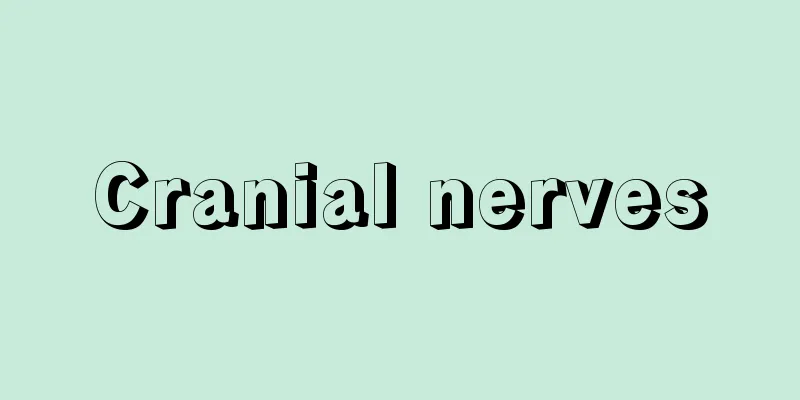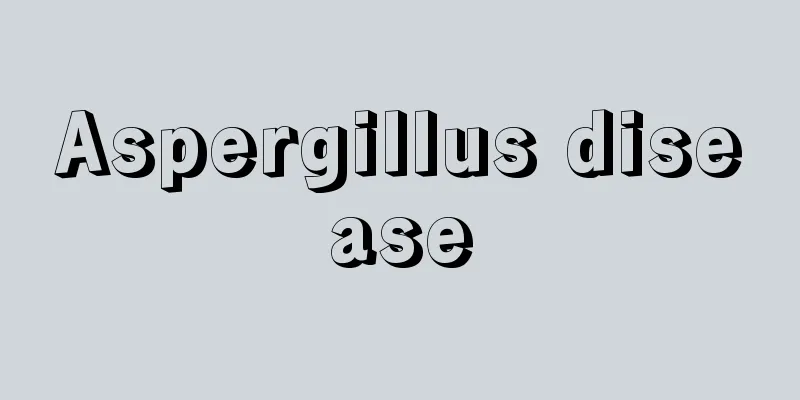Cranial nerves

|
Nerves that enter and exit the brain. That is, the nerves that enter and exit from the base of the medulla oblongata to the frontal lobe are arranged in 12 pairs, from the front to the back, from the 1st cranial nerve to the 12th cranial nerve. Each pair of cranial nerves has its own name: (1) olfactory nerve, (2) optic nerve, (3) oculomotor nerve, (4) trochlear nerve, (5) trigeminal nerve, (6) abducens nerve, (7) facial nerve, (8) vestibulocochlear nerve, (9) glossopharyngeal nerve, (10) vagus nerve, (11) accessory nerve, and (12) hypoglossal nerve. Of these, only the trochlear nerve of the 4th cranial nerve exits from the dorsal part of the brain, but the other 11 pairs all enter and exit from the ventral part of the brain. Cranial nerves exit the skull through various openings or foramina in the base of the skull. Unlike the spinal nerves, some cranial nerves are made up of only sensory or motor fibers, while others are a mixture of both (the spinal nerves are mixed nerves). Motor cranial nerves originate from cells in the brainstem, whereas sensory cranial nerves originate from cells outside the brain, and afferent fibers from these cells enter the brain. [Kazuyo Shimai] Each cranial nerve(1) Olfactory nerve: The nerve that transmits the sense of smell. It is made up of about 20 thin nerve fibers that emerge from sensory cells called olfactory cells in the mucous membrane at the top of the nasal cavity, and enter the olfactory bulb on the underside of the frontal lobe through holes in the cribriform plate at the base of the skull. Olfactory cells are a type of sensory cell, but in humans, they are the only cells whose fibers extend directly into the brain. (2) Optic nerve: The nerve that transmits vision; it is a bundle of afferent fibers from ganglion cells in the retina. (3) Oculomotor nerve: Nerve fibers emanating from the cells of the oculomotor nucleus in the midbrain, mainly consisting of motor nerve fibers that control the levator superior palpebrae, superior rectus, inferior rectus, medial rectus, and inferior oblique muscles, which move the eyeball. The parasympathetic nerves involved in pupillary constriction are also included in the oculomotor nerve. (4) Trochlear nerve: Nerve fibers emerging from the trochlear nucleus in the midbrain; it is a motor nerve that distributes to the superior oblique muscle of the eye. (5) Trigeminal nerve: The largest of the cranial nerves, it enters and exits from the central outer part of the pons. It is a mixed nerve consisting of sensory and motor nerves. (6) Abducens nerve: This motor nerve emerges from the abducens nucleus in the dorsal pons, leaves the brain at the border between the pons and the medulla oblongata medial to the medulla oblongata, and enters the orbit through the superior orbital fissure. It controls the lateral rectus muscle of the eye. Contraction of this muscle causes the eye to turn outward. (7) Facial nerve: It originates from the border between the pons and the medulla oblongata. It is mainly composed of motor nerves that distribute to the facial muscles, and its nerve fibers originate from the facial nucleus in the medulla oblongata. The facial nerve also includes the salivary secretory nerve (nerve intermedius). (8) Vesito-cochlear nerve Enters the medulla oblongata along with the facial nerve (old scientific name: auditory nerve). It is a mixed nerve consisting of afferent nerves from the nerve cells of the vestibular ganglion and cochlear ganglion in the temporal bone, that is, the vestibular nerve and the cochlear nerve. The vestibular nerve ends in the semicircular canal, utricle, and saccule of the inner ear, and transmits the sense of balance. The cochlear nerve ends in the organ of Corti in the cochlear duct of the inner ear, and transmits the sense of hearing. (9) The glossopharyngeal nerve is a mixed nerve that originates from the lateral part of the medulla oblongata and transmits sensory, motor, and gustatory sensations. It is a complex nerve that is composed of taste fibers in the tongue, sensory fibers in the mucous membranes of the pharynx and middle ear, motor fibers that innervate some of the pharyngeal muscles, and parasympathetic fibers that regulate the secretions of the parotid gland. (10) Vagus nerve This nerve fiber originates from the dorsal nucleus of the vagus nerve in the medulla oblongata, and emerges from the outside of the medulla oblongata. In the past, its distribution was unclear, so it was given the name vagus nerve. It has the widest distribution of all cranial nerves. The vagus nerve is mainly a mixed parasympathetic nerve, and its distribution extends to the head, neck, chest, and abdomen. In the head, it is distributed to the dura mater of the brain, as well as the skin of the ear and external auditory canal. In the neck, it is distributed to the mucous membrane and muscles of the pharynx and larynx. The recurrent laryngeal nerve, a branch of the vagus nerve that is distributed to the mucous membrane and muscles of the larynx, is a nerve that is clinically subject to paralysis, and is considered an important nerve because it causes symptoms such as impaired vocalization and hoarseness. In the chest, it sends branches to the heart and lungs, as well as to the trachea, bronchi, and esophagus. In the abdomen, it sends branches to abdominal organs other than the lower part of the large intestine and the pelvic organs. (11) Accessory nerve: A motor nerve, part of which emerges from the medulla oblongata (medullary root) and part of which emerges from the spinal cord (spinal root) to form a single nerve that controls the trapezius and sternocleidomastoid muscles. (12) Hypoglossal nerve: This motor nerve arises from the hypoglossal nucleus at the lower end of the medulla oblongata, leaves the medulla oblongata between the medullary pyramid and the olive (an oblong-shaped protuberance on the posterior outer side of the medullary pyramid), and controls the tongue muscle proper, some accessory muscles of the tongue, and the infrahyoid muscles. Reptiles and animals above the age of 12 have 12 pairs of cranial nerves, cyclostomes have 8 pairs, and fish and amphibians have 10 pairs. Galen, a leading anatomist in ancient medicine, considered there to be 7 pairs of cranial nerves. Later, the 17th century British brain anatomist T. Willis counted there to be 10 pairs. It is said that the German anatomist ST von Sömmering was the one who first came up with the current number of 12 pairs of cranial nerves. [Kazuyo Shimai] [References] | | | | | | |Source: Shogakukan Encyclopedia Nipponica About Encyclopedia Nipponica Information | Legend |
|
脳から出入する神経をいう。すなわち、延髄から前頭葉にかけて、その底部から出入する神経で、前方から順に第1脳神経から第12脳神経まで12対が配列している。各対の脳神経には、それぞれ次のような固有の名称がつけられている。(1)嗅(きゅう)神経、(2)視神経、(3)動眼神経、(4)滑車神経、(5)三叉(さんさ)神経、(6)外転神経、(7)顔面神経、(8)内耳神経、(9)舌咽(ぜついん)神経、(10)迷走神経、(11)副神経、(12)舌下神経。このうち、第4脳神経の滑車神経だけは脳の背側部分から出るが、その他の11対はすべて脳の腹側から出入りする。 脳神経は頭蓋(とうがい)骨底にあるいろいろな開口部や孔を通って頭蓋骨の外に出る。脳神経は脊髄(せきずい)神経と異なり、感覚神経線維あるいは運動神経線維だけで構成されるものもあれば、両者が混合しているものもある(脊髄神経は混合神経)。運動性の脳神経の場合、その起始細胞は脳幹部にあるが、感覚性の脳神経では、その起始細胞が脳の外部に存在し、その神経細胞からの求心線維が脳に入る。 [嶋井和世] それぞれの脳神経(1)嗅神経 嗅覚を伝える神経。鼻腔(びくう)上部の粘膜内にある嗅細胞という感覚細胞から出る20本ほどの細い神経線維で、頭蓋底の篩骨(しこつ)篩板の孔を通って前頭葉下面の嗅球に入る。嗅細胞は一種の感覚細胞であるが、こういう感覚細胞から出た線維が脳に直接入るのは、ヒトではこの細胞だけである。 (2)視神経 視覚を伝える神経で、網膜内の神経節細胞の求心線維束である。 (3)動眼神経 中脳の動眼神経核の細胞から出る神経線維で、眼球を動かす眼筋のうち、上眼瞼(じょうがんけん)挙筋、上直筋、下直筋、内直筋、下斜筋を支配する運動神経線維が主体となる。瞳孔(どうこう)の収縮に関係する副交感神経も動眼神経のなかに含まれている。 (4)滑車神経 中脳の滑車神経核から出る神経線維で、眼筋の上斜筋に分布する運動神経である。 (5)三叉神経 脳神経のうちではもっとも太い神経で、橋(きょう)の外側中央部から出入りする。感覚神経と運動神経からなる混合神経である。 (6)外転神経 橋背部の外転神経核から出て、橋と延髄の境でその内側から脳を去り、上眼窩(がんか)裂から眼窩に入る運動神経で、眼球の外側直筋を支配する。この筋の収縮により、眼球は外側に向く。 (7)顔面神経 橋と延髄の境から出る。顔面の表情筋に分布する運動神経が主体で、その神経線維は延髄の顔面神経核から出る。顔面神経は、このほか、唾液(だえき)分泌神経(中間神経)を含む。 (8)内耳神経 顔面神経と並んで延髄に入る(旧学名は聴神経)。側頭骨内にある前庭神経節や蝸牛(かぎゅう)神経節の神経細胞からの求心性の神経、すなわち、前庭神経と蝸牛神経とで構成される混合神経である。前庭神経は内耳の三半規管・卵形嚢(のう)・球形嚢に終わり、平衡感覚を伝える。蝸牛神経は同じく内耳の蝸牛管にあるコルチ器に終わり、聴覚を伝える。 (9)舌咽神経 延髄の外側部から出る、知覚・運動・味覚を伝える混合神経である。すなわち、舌の味覚線維、咽頭・中耳粘膜の知覚線維、一部の咽頭筋を支配する運動線維、および耳下腺(せん)の分泌を調節する副交感性線維から構成される複雑な神経である。 (10)迷走神経 延髄の迷走神経背側核からの神経線維で、延髄外側から出ているが、古くはその分布が明らかでなかったため、迷走神経の名がつけられた。脳神経のうちではもっとも分布範囲が広い。迷走神経は主として副交感性混合神経で、その分布は頭部、頸部(けいぶ)、胸部、腹部に及ぶ。頭部では脳硬膜のほか、耳介・外耳道の皮膚に分布する。頸部では咽頭・喉頭(こうとう)の粘膜や筋に分布する。喉頭の粘膜と筋に分布する迷走神経の枝の反回神経は、臨床上、麻痺(まひ)の対象となる神経で、発声運動の障害、嗄(さ)声などの症状の原因となるので重要な神経とされる。胸部では心臓、肺臓に枝を送るほか、気管、気管支、食道に分布する。腹部では大腸下部と骨盤内器官以外の腹部臓器に枝を送っている。 (11)副神経 運動神経で、一部は延髄(延髄根)、一部は脊髄(脊髄根)から出て1本になり、僧帽筋と胸鎖乳突筋とを支配する。 (12)舌下神経 延髄下端部にある舌下神経核から出て、延髄錐体(すいたい)とオリーブ(延髄錐体の外後側にある長楕円(ちょうだえん)形の膨らみ)との間から延髄を去り、固有の舌筋と、一部の舌付属筋、舌骨下筋群を支配する運動神経である。 脳神経が12対あるのは爬虫(はちゅう)類以上の動物で、円口類は8対、魚類・両生類は10対である。古代医学において解剖学の大家であったガレノスは7対の脳神経を考えた。その後、17世紀のイギリスの脳解剖学者ウィリスT. Willisは10対の脳神経を数えている。現在のように脳神経を12対としたのはドイツの解剖学者ゼンメリンクS. T. von Sömmeringといわれている。 [嶋井和世] [参照項目] | | | | | | |出典 小学館 日本大百科全書(ニッポニカ)日本大百科全書(ニッポニカ)について 情報 | 凡例 |
>>: Agricultural calendar - Noujireki
Recommend
Ochi Naoyoshitsugu - Ochi no Atakiyotsugu
…Many members of the family had the surname Atai....
chancel
…In the 9th century, a square or rectangular spac...
Grand Master of Seasons - Grand Master of Seasons
Year of death: August 7, 1487 (August 25, 1487) Ye...
cholestasis
In the blood of a normal person, serum bilirubin ...
Iga (Clothes Moth) - Iga
A species of the family Tineidae in the order Lepi...
Active Krankenbehandlung (English spelling) Active Krankenbehandlung
…The history of psychiatric occupational therapy ...
Mount Sumeru
A giant mountain at the center of the world in Bu...
Phonon echo
This refers to the phenomenon and pulse signal in ...
Disarray - Chaos
The titles of Japanese music pieces, Noh music and...
Oboro tofu - Oboro tofu
...When the temperature of the soy milk has dropp...
Cyrillomethodiana
…Slavic studies first developed as Slavic philolo...
Chaldeans - Chaldeans (English spelling)
One of the Semitic nomads who founded the Neo-Baby...
Hectocotylus octopodis (English spelling) Hectocotylusoctopodis
…In the families Hectocotylidae and Hectocotylida...
Regression
Mental development stops and moves in the opposit...
Atahui - Atahui
...A faction of the Yuan army, consisting mainly ...









